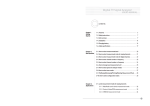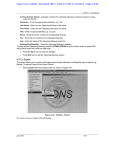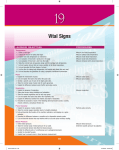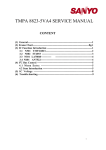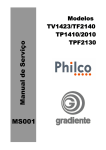Download KALLEY SERVICE MANUAL
Transcript
KALLEY K-TV21PF & K-TV29PF with NTSC/PALm/PALn SERVICE MANUAL COLOR TELEVISION . CONTENTS 1. safety precautions………………………………………………………………………………………3 2. block diagram and PHILIPS UOC functional difference between the various IC versions ………………….4 3. . Replacement of memory IC……………………………………………………………………………7 4. . Service adjustment……………………………………………………………………………………...7 5. . ICs functional description………………………………………………………………………………11 6. . Test point waveform………………………………………………………………………………….…15 7. . All ICs/transistors voltages…………………………………………………………………………….16 8. . Purity / convergence adjustment……………………………………………………………………..17 2 . SAFETY PRECAUTIONS 1. The design of this product contains special hardware, many circuits and components specially for safety purposes. For continued protection, no changes should be made to the original design unless authorized in writing by the manufacturer. Replacement parts must be identical to those used in the original circuits. Service should be performed by qualified personnel only. 2. Alterations of the design or circuitry of the products should not be made. Any design alterations or additions will void the manufacturer’s warranty and will further relieve the manufacturer of responsibility for personal injury or property damage resulting therefrom. 3. Many electrical and mechanical parts in the products have special safety-related characteristics. These characteristics are often not evident from visual inspection nor can the protection afforded by them necessarily be obtained by using replacement components rated for higher voltage, wattage, etc. Replacement parts which have these special safety characteristics are identified in the parts list of Service manual. Electrical components having such features are identified by shading on the schematics and by ( ! ) on the parts list in Service manual. The use of a substitute replacement which does not have the same safety characteristics as the recommended replacement part shown in the parts list of Service manual may cause shock, fire, or other hazards 4. Don’t short between the LIVE side ground and ISOLATED (NEUTRAL) side ground or EARTH side ground when repairing. Some model’s power circuit is partly different in the GND. The difference of the GND is shown by the LIVE: ( ) side GND, ISOLATED (NEUTRAL) : ( ) side GND and EARTH : ( ) side GND. Don’t short between the LIVE side GND and ISOLATED (NEUTRAL) side GND or EARTH side GND and never measure with a measuring apparatus (oscilloscope etc.) the LIVE side GND and ISOLATED (NEUTRAL) side GND or EARTH side GND at the same time. If above note will not be kept, a fuse or any parts will be broken. 5. If any repair has been made to the chassis, it is recommended that the B1 setting should be checked or adjusted (See ADJUSTMENT OF B1 POWER SUPPLY). 6. The high voltage applied to the picture tube must conform with that specified in Service manual. Excessive high voltage can cause an increase in X-Ray emission, arcing and possible component damage, therefore operation under excessive high voltage conditions should be kept to a minimum, or should be prevented. If severe arcing occurs, remove the AC power immediately and determine the cause by visual inspection (incorrect installation, cracked or melted high voltage harness, poor soldering, etc.). To maintain the proper minimum level of soft X-Ray emission, components in the high voltage circuitry including the picture tube must be the exact replacements or alternatives approved by the manufacturer of the complete product. 7. Do not check high voltage by drawing an arc. Use a high voltage meter or a high voltage probe with a VTVM. Discharge the picture tube before attempting meter connection, by connecting a clip lead to the ground frame and connecting the other end of the lead through a 10kΩ 2W resitor to the anode button. 8. When service is required, observe the original lead dress. Extra precaution should be given to assure correct lead dress in the high voltage circuit area. Where a short circuit has occurred, those components that indicate evidence of overheating should be replaced. Always use the 9. manufacturer’s replacement components. 10. Isolation Check (Safety for Electrical Shock Hazard) After re-assembling the product, always perform an isolation check on the exposed metal parts of the cabinet (antenna terminals, video/audio input and output terminals, Control knobs, metal cabinet, screwheads, earphone jack, control shafts, etc.) to be sure the product is safe to operate without danger of electrical shock. 11. The surface of the TV screen is coated with a thin film which can easily be damaged. Be very careful with it when handle the TV. Should the TV screen become soiled, wipe it with a soft dry cloth. Never rub it forcefully. Never use any cleaner or detergent on it. (1) (2) 3 Dielectric Strength Test The isolation between the AC primary circuit and all metal parts exposed to the user, particularly any exposed metal part having a return path to the chassis should withstand a voltage of 3000V AC (r.m.s.) for a period of one second. (…Withstand a voltage of 1100V AC (r.m.s.) to an appliance rated up to 120V, and 3000V AC (r.m.s.) to an appliance rated 200V or more, for a periode of one second.) This method of test requires a test equipment not generally found in the service trade. Leakage Current Check Plug the AC line cord directly into the AC outlet (do not use a line isolation transformer during this check.). Using a “Leakage Current Tester”, measure the leakage current from each exposed metal part of the cabinet, particularly any exposed metal part having a return path to the chassis, to a known good earth ground (water pipe, etc.). Any leakage current must not exceed 0.5mA AC (r.m.s.). However, in tropical area, this must not exceed 0.2mA AC (r.m.s.). ●Alternate Check Method Plug the AC line cord directly into the AC outlet ( do not use a line isolation transformer during this check.). Use an AC voltmeter having 1000 ohms per volt or more sensitivity in the following manner. Connect a 1500Ω 10W resistor paralleled by a 0.15μF AC-type capacitor between an exposed metal part and a known good earth ground (water pipe, etc.). Measure the AC voltage across the resistor with the AC voltmeter. Move the resistor connection to each exposed metal part, particularly any exposed metal part having a return path to the chassis, and measure the AC voltage across the resistor. Now, reverse the plug in the AC outlet and repeat each measurement. Any voltage measured must not exceed 0.75V AC (r.m.s.). This corresponds to 0.5mA AC (r.m.s.). However, in tropical area, this must not exceed 0.3V AC (r.m.s.). This corresponds to 0.2mA AC (r.m.s.) . 2 TV Block diagram for PALm/PALn TDA9361 video TUNER SAW S TRAP IF IN Y IN Y RF AGC BAND1 BAND2 CVBSINT V IN Cr U IN Cb Vo V2i video 4052 video V1i video Y S-VHS CHROMA IFVO OUT video C CVBS/Y IN ARo audio 24C04 ALo AUDIO OUT V OUT IK RGB OUT H OUT ARi2 TDA9850 ARi1 XS303 A OUTR A OUTL MAIN L MAIN R SDA/SCL AV2 R AV2 R M OUTR M OUTL AV1 L AV2 L SDA SCL 7 4 5 1 2 6 7 8 bus BTSC TDA9859 ALi2 5V bus ALi1 audio audio AN7522 CRT PCB 130V POWER UNIT H IN V IN 24V TDA8351 16V 8V V OUT CD8145 EW H OUT 200V audio +15V -15V H OUT SCREEN FOCUS 5V 3.3V DY 4 CRT Vi1 OUT1OUT1+ Vi2 OUT2OUT2+ . PHILIPS UOC FUNCTIONAL DIFFERENCE BETWEEN THE VARIOUS IC VERSIONS IC VERSION 9350 9351 9352 9353 9360 9361 9362 9363 9364 9365 9366 9367 9380 9381 9382 9383 9384 9385 9386 9387 9388 9389 9370 9373 9375 9377 9378 TV rang 90 90 Mono inter-carrier multi-standard √ Audio switch Automatic volume leveling 90 110 90 90 110 110 √ √ √ √ √ √ √ √ √ √ √ √ √ √ √ 110 110 90 90 90 90 √ √ √ 90 110 110 √ √ √ √ √ √ √ 110 110 90 110 110 90 √ √ √ √ √ √ √ √ 110 110 90 110 √ √ √ √ √ √ Sound demodulator (4.5-6.5MHz) With switch able centre frequency √ √ Automatic volume leveling or √ √ √ √ √ √ √ √ √ √ √ √ √ √ √ √ √ √ √ √ √ √ Subcarrier output (for comb filter applications) √ QSS sound IF amplifier with √ √ √ √ √ Separate input and AGC circuit √ AM sound demodulator without √ Extra reference circuit PAL decoder √ SECAM decoder NTSC decoder √ √ √ √ √ √ √ √ √ √ √ √ √ √ √ √ √ √ √ √ √ √ √ √ √ √ √ √ √ √ √ √ √ √ √ √ √ √ √ √ √ √ √ √ √ √ √ √ √ √ √ √ √ √ √ √ √ √ √ Horizontal geometry(E-W) √ √ √ √ √ √ √ √ √ √ √ √ √ √ Horizontal and vertical zoom √ √ √ √ √ √ √ √ √ √ √ √ √ √ 64- 64- 64- 64- 16- 16- 16- 16- 16- 16- 32- 32- 32- 64k 64k 64k 64k 128 128 128 128 128 128 128 128 64k 64k 64k 64k 64k 64k 64k 64k 64k 64k 55k 55k 55k 55k 55k User RAM size 1k 1k 1k 1k 2k 2k 2k 2k Teletext 1p 1p 1p 1p 10p 10p 10p 10p 10p 10p 10p 10p Closed captioning √ √ √ √ √ ROM size 32- 32- 32- 32- 64- 64- 2k √ 2k √ √ √ √ 64- 64- 2k 2k √ √ 16- 16- 16- 32- 32- 1k 1k 1k 1k 1k 1k 1k 1k 1k 1k 2.25 2.25 2.25 2.25 2.25 √ √ √ √ √ √ √ √ √ √ √ Block diagram TDA93xX PS/N2 series with mono intercarrier sound demodulator 5 16- √ √ √ √ . 6 3.REPLACEMENT OF MEMORY IC 1. MEMORY IC. This TV uses memory IC. In the memory IC are memorized data for correctly operating the video and deflection circuits. When replacing memory IC, be sure to use IC written with the initial value of data. 2. PROCEDURE FOR REPLACING MEMORY IC (1) Power off Switch the power off and unplug the power cord from AC outlet. (2) Replace IC Be sure to use memory IC written with the initial data values. (3) Power On Plug the power cord into the AC outlet and switch the power On. (4) Check and set SYSTEM default value: 1) Press “QV” key holding about 4 second and then press “MENU1” key on the Remote control unit. Or Press “TEST” key on the Remote control unit for factory used. 2) The “TEST” will be displayed on the screen. 3) Press digital key, (Mkey) and corresponding on-screen display will be appeared. Some time “PASSWORD” on-screen display will be appeared, you need to input 828. 4) Check the setting value of the SYSTEM default value of Table below. If the value is different, select items by [CH+]/[CH-] keys and set value by [VOL+]/[VOL-] keys. 5) Press “STANDBY” key again and return to the normal screen. 4.SERVICE ADJUSTMENT B1 POWER SUPPLY 1. Receive normal colour bar signal. 2. Connect DC voltmeter to VD541- and isolated ground. 3. Adjust potentiometer in power unit to get the voltage as 110V ±1.0V for 21 inch hereinafter, 130 ±1.0V for 25 inch upwards. FOCUS ADJUSTMENT 1. Receive a crosshatch signal. 2. While watching the screen, adjust the FOCUS VR to make the vertical and horizontal lines as fine and sharp as possible. EW ADJUSTMENT(only upper 25 inch) 1. adjust VR433 for horizontal size, to get 90% of horizontal picture contents would be displayed on CRT. 2. adjust VR432 for EW parabola, to straighten the vertical at the sides. 3. adjust VR431 for EW trapezium, to set the line at the sides vertical. 7 BUS CONTROL ADJUSTMENT 1. first color value set to 0, then Press “TEST” key on the Remote control unit of factory. Press “0” to “9“ key, (Mkey) and corresponding on-screen display will be appeared. But to enter M4-M9, Must input passcord 828. On TV screen “TEST” will be indicated, this means entered bus control mode. And press following key, each function will be available. 3. may be intered TEST mode with remote control unit of user, press QV key and hold 4 seconds. and then press MENU key, TV set may be entered TEST mode. Remote Hand Unit keys [M1] [M2] [M3] [M0] MENU1 V.SLOPE V.SHIFT V. SIZE V.S H.SHIFT 31 31 31 31 31 [M1] menu MENU0 Geometrical adjustment Receive PAL standard Complete pattern signal. Adjustment steps: a) Adjust V. SLOPE, to the center horizontal line just appeare from half bottom shadow. b) Adjust V. SIZE, to get 90% of vertical picture contents would be displayed on CRT. c) Adjust V. SHIFT, the center horizontal line correspond to CRT vertical center. d) Adjust H.SHIFT, to get the picture horizontal center correspond to CRT horizontal center. Receive NTSC signal and repeat above [M0] and [M1] adjustment. [M2] Menu AGC Adjustment. Receive 60dBμ(1mV)VH colour bar pattern signal,adjust AGC value(voltage from high to low),to noise reduce gradually and just disappeared point. [M3] Menu CRTcut off and white balance adjustment. Receive white signal. a) CRT cut off adjustment. 1. Select “SC”, then automatically vertical scan will be stopped. 2. Adjust SCREEN control on Flyback transformer to get the darkest single horizontal line (red, green, or blue, sometimes shows more yellow, more purple or more white). b) White balance adjustment. 1. Select RD/BD menu. 2. Adjust RD/BD to get colour temperature as x=281, y=311 c) Sub-Brightness adjustment. (Use stair case signal) 1. Select SB menu. 2. Adjust SB to get the darkest step being cutoff. 8 ICs Default Settings a) TDA9370(STANDARD) EK cord=NTDA9370---2NA MI Items M1 FREQUENCY Variable Preset MI Items Variable Preset 50HZ M5 SUB Contrast 0~63 63 V.SLOPE 0~63 31 SUB color 0~63 63 V.SHIFT 0~63 31 SUB sharp 0~63 63 V.SIZE 0~63 31 SUBTINT 0~15 15 V.S 0~63 31 SUB Volume 0~63 63 H.SHIFT 0~63 31 OSD. V.POS 0~63 53 OSO ON/OFF ON OSD.H.POS 0~59 15 AGC-SPEED 0~3 2 FFI ON/OFF OFF FSL ON/OFF ON FMWS ON/OFF OFF PRO 0~3 0 M6 PROGRAM NO M2 AGC Takeover 0~63 25 SHIPMODE NTSC MX M3 BT 0~63 48 CT 0~63 48 SC M4 M7 USA STANDARD BRI 0~63 48 OFF STANDARD CONT 0~63 48 RB 0~63 32 STANDARD COL 0~63 48 GB 0~63 32 SHARP BRI 0~63 48 RD 0~63 32 SHARP CONT 0~63 63 GD 0~63 32 SHARP COL 0~63 32 BD 0~63 32 SOFT BRI 0~63 32 SB 0~63 40 SOFT CONT 0~63 32 SOFT COL 0~63 32 AV CFG* 0~8 3 BTSC-MODE STEREO UOC VOLUME 0~63 34 M8 BTSC-ST 0~15 15 YDLY PAL 0~15 12 BTSC-SP 0~15 15 YDLY AV 0~15 12 BTSC-LI 0~15 12 SC BRIGHT 0~63 10 BTSC-A1 0~31 0 CATHODE LEVEL 0~15 10 BTSC-A2 0~31 31 HEADPHONE ON/OFF OFF BTSC-TC 0~7 3 VM OPTION ON/OFF OFF BTSC-STS 0~1 0 BTSC-ADJ AUTO START ON 0~2 0 START TIME 0~15 8 M9 9 5. ICs functional description UOC TDA93XX SYMBOL PIN DESCRIPTION STAND BY output. 1 In STAND BY mode, high level (Power OFF). For Power ON this pin will be reduced to low. SCL 2 I2C-bus clock line SDA 3 I2C-bus data line TUNING 4 tuning Voltage (Vt) PWM output P3.0/NTSC SW 5 Port 3.0 or NTSC output/SCART SW input, Forced NTSC selection, Low-level output, otherwise High output. KEY 6 Control keys input *3 VOL 7 Sound Volume control PWM output MUTE 8 Sound mute output VSSC/P 9 Digit ground for µ-controller core and periphery BAND1 10 Tuner Band selection output BAND2 11 Tuner Band selection output VSSA 12 Analog ground of teletext decoder and digital ground of TV-processor SECPLL 13 SECAM PLL decoupling VP2 14 2nd supply voltage TV-processor(+8V) DECDIG 15 decoupling digital supply of TV-processor PH2LF 16 Phase-2 filter PH1LF 17 Phase-1 filter GND3 18 Ground 3 for TV-processor DECBG 19 Band gap decoupling AVL/EWD 20 Automatic volume leveling /EAST-WEST drive output VDRB 21 Vertical drive B output VDRA 22 Vertical drive A output IFIN1 23 IF input 1 IFIN2 24 IF input 2 IREF 25 Reference current input VSC 26 Vertical sawtooth capacitor TUNER AGC 27 Tuner AGC output AUDEEM/SIFIN1 *1 28 Audio deemphasis or SIF input DECSDEM/SIFIN2 29 decoupling sound demodulator or SIF input 2 GND2 30 ground 2 for TV processor SNDPLL/SIFAGC *1 31 narrow band PLL filter or AGC sound IF AVL/SNDIF/REF0/ AMOUT *1 32 Automatic Volume Levelling / sound IF input / subcarrier reference output / audio HOUT 33 horizontal output FBISO 34 flyback input/sandcastle output deemphasis 10 AUDEXT/QSSO/ AMOUT *1 35 external audio output / QSS intercarrier out EHTO 36 EHT/overvoltage protection input PLL IF 37 IF-PLL loop filter IFVO/SVO 38 IF video output / selected CVBS output VP1 39 supply voltage TV processor CVBS INT 40 internal CVBS input GND1 41 ground for TV processor CVBS/Y 42 CVBS/Y input CHROMA 43 C input AUDOUT/AMOUT *1 44 audio output /AM audio output (volume controlled) INSSW2 45 2nd RGB / YUV insertion input R2/VIN 46 2nd R input / V (R-Y) input / PR input G2/YIN 47 2nd G input / Y input B2/UIN 48 2nd B input / U (B-Y) input / PB input BCLIN 49 beam current limiter input BLKIN 50 black current input / V-guard input RO 51 Red output GO 52 Green output BO 53 Blue output VDDA 54 analog supply of Closed Caption decoder and digital supply of TV-processor (3.3 V) VPE 55 OTP Programming Voltage VDDC 56 digital supply to core (3.3 V) OSCGND 57 oscillator ground supply XTALIN 58 crystal oscillator input XTALOUT 59 crystal oscillator output RESET 60 reset VDDP 61 digital supply to periphery (+3.3 V) P1.0/INT1 62 TV/AV (AV1) / AV2 /S-VHS mode Output. P1.1/T0 63 TV/AV (AV1) / AV2 /S-VHS mode Output. P1.2/INT0 64 Remote control signal input. Note 1. The function of pin 20, 28, 29, 31, 32, 35 and 44 is dependent on the IC version (mono intercarrier FM demodulator /QSS IF amplifier and East-West output or not) and on some software control bits. The valid combinations are given in table 1. 2. the vertical guard function can be controlled via pin 49 or pin 50. the selection is made by means of the IVG bit in subaddress 2BH. 11 TABLE 1 IC version FM-PLL version East-West QSS version N Y N Y Y/N CMB1/CMB 00 01/10/1 1 00 01/10/1 1 00 - - - - - 0 bits AM bits AVL Pin 20 EWD 01/10/11 0 00 1 SIFIN1 Pin 29 DECSDEM SIFIN2 Pin 31 SNDPLL SIFAGC REFO(2) ) AVL/SNDIF(1 REFO(2) 1 EWD AUDEEM SNDIF(1 0 AVL Pin 28 Pin 32 01/10/11 AMOUT REFO(2) AUDEXT QSS AMOU O T AMOUT REFO(2) AUDEXT QSS AMOU O T ) Pin 35 AUDEXT Pin 44 AUDOUT Controlled AM or audio out Note 1. When additional (external) selectivity is required for FM-PLL system pin 32 can be used as sound IF input. This function is selected by means of SIF bit in subaddress 28H. 2. the reference output signal is only available for the CMB1/CMB0 setting of 0/1. for the other settings this pin is a switch output(see also 5 table 67). Pin No. 6: Control keys input (Max. Limit voltage) Function POWER MENU TV/AV V- V+ P- P+ Voltage 0 0.4125 0.825 1.2375 1.65 2.0625 2.475 12 AN7522/7523 Function : audio output Symbol PIN Function Symbol PIN Function Vcc 1 Power supply GND 7 ground Out 1 (+) 2 Ch 1 output (+) In 2 8 Ch 2 input GND(out 1) 3 Ch 1Ground VOL 9 Volume Control Out 1 (-) 4 Ch 1 output (-) Out 2 (-) 10 Ch 2 output (-) Standby 5 Mute input GND(out 2) 11 Ch 2 Ground In 1 6 Ch 1 input Out 2 (+) 12 Ch 2 output (+) Note: AN7523 is pin 1 to 9, AN7522 is pin 1 to 12. LA78040/78045 Function : vertical output Symbol PIN Function Symbol PIN Function INV IN 1 Input V OUT 5 Vertical output VCC1 2 Power VCC2 6 Output power supply PUMP UP 3 Pump up power NON INV IN 7 Negative feedback GND 4 Ground TDA9859 Function : Universal Sound processor Symbol Pin Function Symbol Pin Function AV1L 1 AV1 Audio Left input AV1R 32 AV1 Audio input Right P1 2 Not used P2 31 Not used MAINL 3 Main Audio Left input AV2R 30 AV2 Audio input Right CSMO 4 Smoothing Capacitor CPS1 29 Pseudo stereo Cap. 1 MAINR 5 Main Audio Right input AV2L 28 AV2 Audio input Left VP 6 Power Supply CPS2 27 Pseudo stereo Cap. 2 OUT R 7 Right Output OUT L 26 Left Output GND 8 Ground MAD 25 Not used (GND) LINOR 9 Line Output Right LINOL 24 Line Output Left LINIR 10 Line Input Right LINIL 23 Line Input Left CBR1 11 Bass Cap. Right 1 CBL1 22 Bass Cap. Left 1 CBR2 12 Bass Cap. Right 2 CBL2 21 Bass Cap. Left 2 Headphone R 13 Headphone-R output Headphone L 20 Headphone-L output CTR 14 Treble Cap. Right CTL 19 Treble Cap. Left MAINOR 15 Main Audio out Right MAINOL 18 Main Audio out Left SCL 16 I2C Bus clock SDA 17 I2C Bus data CD 8145 Function : EW parabola correction Symbol Keystone input PIN 1 Function Symbol Trapezium NON INV IN PIN 8 correction input Sawtooth input 2 frame sawtooth Function Non-inverting 100 ua Current sink INV IN 7 current input Parabola output Inverting input I ref 3 Current reference VCC 6 VCC GND 4 Ground Output 5 Output 13 6. Test point Waveforms 2.6Vpp H TDA93XX PIN38 95Vpp H 1.2Vpp H TDA93XX PIN40 95Vpp CRT KR H CRT KG 1Vpp 0.8Vpp V V TDA93XX PIN21 TDA93XX PIN22 22Vpp 300Vpp H HEATER H T511 PIN7 3.8Vpp 2.5Vpp H TDA93XX PIN53 H TDA93XX PIN52 95Vpp 0.9Vpp H CRT KB 1.3Vpp H TDA93XX PIN33 2.7Vpp H V451 B TDA93XX PIN59 14 2.5Vpp H TDA93XX PIN51 5Vpp H TDA93XX PIN34 1000Vpp H V451 C 7. IC voltages TDA93XX PIN 1 2 3 4 5 6 7 8 9 10 11 12 13 14 15 16 V 2.8 3.8 3.6 3.3 3.5 3.5 0.1 0.1 0 5.4 0.1 0 2.3 8 5 3 PIN 17 18 19 20 21 22 23 24 25 26 27 28 29 30 31 32 V 4 0 4 0.9 0.7 0.8 1.9 1.9 3.9 3.8 1.6 3.2 3.4 0 2.4 0.1 PIN 33 34 35 36 37 38 39 40 41 42 43 44 45 46 47 48 V 0.6 0.5 3.7 1.7 2.4 3.1 8 3.8 0 3.4 1.5 3.6 2.3 2.6 2.6 2.6 PIN 49 50 51 52 53 54 55 56 57 58 59 60 61 62 63 64 V 2.3 7.2 2.7 2.7 2.7 3.5 0 3.5 0.1 1.7 1.8 0 3.5 0.1 0.1 5 LA76040 PIN 1 2 3 4 5 6 7 V 0.7 15 -12 -15 0.3 15.9 -0.07 AN 7522 PIN 1 2 3 4 5 6 7 8 9 10 11 12 V 12 7 0 7 3.3 1.4 0 1.4 0 7 0 7 TDA9859 PIN 1 2 3 4 5 6 7 8 9 10 11 12 13 14 V 4.0 0 4.0 8.0 4.0 8.0 4.0 0 4.0 4.0 4.0 4.0 4.0 4.0 PIN 15 16 17 18 19 20 21 22 23 24 25 26 27 28 V 4.0 4.5 4.6 4.0 4.0 4.0 4.0 4.0 4.0 4.0 0 4.0 4.0 4.0 PIN 29 30 31 32 V 4.0 4.0 0 4.0 CD 8145 PIN 1 2 3 4 5 6 7 8 V 1.6 1.8 8.2 0 9.4 26.5 10 10 15 8. PURITY / CONVERGENCE ADJUSTMENT PURITY ADJUSTMENT WEDGE 1. Demagnetize CRT with the demagnetizer. 2. Loosen the retainer screw of the deflection yoke. 3. Remove the wedges. 4. Input a green raster signal from the signal generator, and turn the screen to green raster. DEFLECTION YOKE P CRT 5. Move the deflection yoke backward. 6. Bring the long lug of the purity magnets on the short lug and position them horizontally. (Fig2) 4 6 P/C MAGNETS 7. Adjust the gap between two lugs so that the GREEN RASTER will come into the center of the screen. (Fig. 3) 8. Move the deflection yoke forward, and fix the position of the deflection yoke so that the whole screen will become green. 9. Insert the wedge to the top side of the deflection yoke so that it will not move. P: PURITY MAGNET 4: 4-POLES (convergence magnets) 6: 6-POLES (convergence magnets) Fig. 1 PURITY MAGNETS Long lug 10. Imput a crosshatch signal. 11. Verify that the screen is horizontal. 12. Input red and blue raster signals, and make sure that Short lug purity is properly adjusted. Bring the long lug over the short lug and position them horizontally. Fig. 2 (FRONT VIEW) GREEN RASTER CENTER Fig. 3 16 STATIC CONVERGENCE ADJUSTMENT 1. Input a crosshatch signal. 2. Using 4-pole convergence magnets, overlap the red and blue lines in the center of the screen (Fig. 1) and turn them to magenta (red/blue). 3. Using 6-pole convergence magnets, overlap the magenta (red/blue) and green lines in the center of the screen and turn them to white. (FRONT VIEW) 4. Repeat 2 and 3 above, and make the best convergence. Fig. 1 (FRONT VIEW) DYNAMIC CONVERGENCE ADJUSTMENT RED 1. Move the deflection yoke up and down and overlap lines in the periphery. (Fig. 2) GREEN BLUE BLUE 2. Move the deflection yoke left to right and overlap the lines in the periphery. (Fig. 3) GREEN 3. Repeat 1 and 2 above, and make the best convergence. RED GREEN RED BLUE BLUE GREEN RED Fig.2 (FRONT VIEW) After adjustment, fix the wedge at the original position. Fasten the retainer screw of the deflection yoke. Fix the 6 magnets with glue. RED GREEN BLUE BLUE GREEN RED RED GREEN BLUE BLUE GREEN RED 17





















